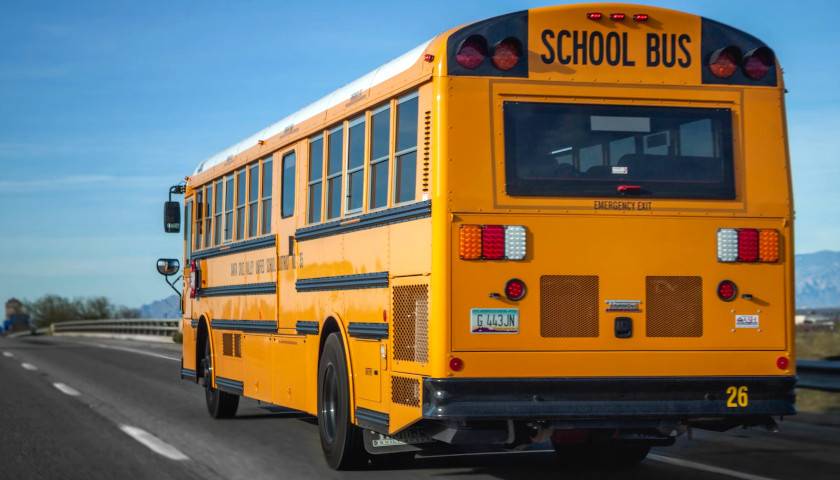by John Solomon
President Joe Biden’s signature $5 billion program to convert the nation’s school buses to an electric fleet has collided with a formidable challenge: a lack of charging infrastructure and power generation from local utilities.
The Environmental Protection Agency’s internal watchdog issued a report just before the New Year’s holiday that offered the latest evidence of a cart-before-horse dynamic in the Democratic push for green energy.
“The Agency may be unable to effectively manage and achieve the program mission unless local utility companies can meet increasing power supply demands for electric school buses,” the inspector general reported candidly, blaming in prt agency officials for not putting more early emphasis on school districts coordinating with their power companies.
“The EPA provided utility resources during the rebate application process but did not require applicants to contact their utility provider to coordinate potential changes needed to connect charging stations to utilities,” the report noted. “While early coordination with utilities is not a requirement, it could prevent the Agency from achieving its objective to remove older diesel buses and replace them with clean buses.”
The electric school bus initiative was boosted by Biden’s Infrastructure Investment and Jobs Act, setting aside $5 billion to grant money to local school district to convert their fleets from gas and diesel. Vice President Kamala Harris took the lead in rolling out the grants last year at a much ballyhooed event.
“Who doesn’t love a yellow school bus?,” Harris asked in October 2022 as she noted that 95% of the buses that carry school children each day burn diesel.
“What we’re announcing today is a step forward in our nation’s commitment to be a leader on these issues to reduce greenhouse gas emissions, to invest in our economy, to invest in job creation, to invest in building the skills of America’s workforce — all with, as that young leader this morning said to me, a goal of not only saving our children, but, for them, saving our planet,” Harris added.
Nearly 2,000 school districts applied for the first round of rebates from all 50 states and Washington, D.C., leading to an initial round of $1 billion. But since then, school districts around the nation have encountered serious difficulties, from a lack of chargers to maintenance problems, repair parts supplies, and downtime on the new technology, according to a recent analysis in Real Clear Energy.
The EPA Inspector General (IG) warned in its new report the problems could persist if school districts don’t synch better with utility officials and pace purchases to the ability of the power grid to expand.
“We identified concerns with delays related to the infrastructure needed to support the bus charger manufacturers and the increased demand on utilities,” the report warned. “Entities we interviewed identified concerns about possible delays with utility providers bringing the necessary power lines and transformers to the school districts for charging the buses.
One utility company told the IG that while it had experience with electric vehicles and buses, “it did not have experience at the projected scale,” the report noted.
Another utility estimated it could take nine months to two years to complete construction, meaning new electric buses could sit idle on lots.
“The most common infrastructure upgrades needed to support the bus chargers are transformers, electrical lines, and switch changers. This utility noted that early communication between the companies and school districts, such as prior to applying for funding, is important for the execution of this program,” the report added.
While issue stern warnings, the IG report also had some bright news for proponents of the project. So far, the supply chain needed for batteries and electric components for buses has kept up, the report noted.
And the EPA has modified its latest round of grants to require better coordination with utilities.
“On September 28, 2023, the Agency announced the second Clean School Bus rebate program. Under this new rebate program, all applicants must submit a Utility Partnership Agreement to verify that the school district’s electric utility provider is aware of the school district’s rebate application. Proactive and ongoing communication between the school district and its local electricity providers is critical to successful infrastructure deployment,” the report said.
But the IG also warned that as things get rolling, the supply of needed charging devices may not keep pace.
“The process for establishing charging stations and connecting them to power lines could take approximately 12 to 24 months, according to the World Resources Institute’s Electric School Bus Buyers Guide,” it cautioned.
– – –
John Solomon is an award-winning investigative journalist, author and digital media entrepreneur who serves as Chief Executive Officer and Editor in Chief of Just the News. Before founding Just the News, Solomon played key reporting and executive roles at some of America’s most important journalism institutions, such as The Associated Press, The Washington Post, The Washington Times, Newsweek, The Daily Beast and The Hill.




